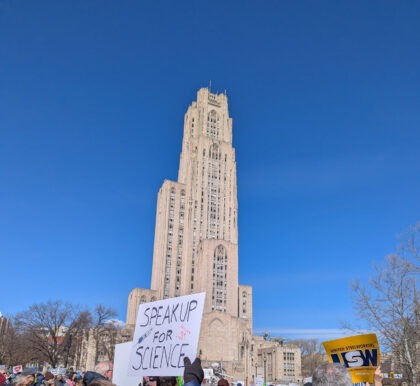
Even with the loss of an hour, lately it seems like we are packing more news into each day than we used to. And so much of the news lately has been science-related; not necessarily new discoveries–although those are happening too–but the enterprise of science itself is getting more attention. So, we’ll trying something a little different this month and try to touch on a few topics in brief. First up, some very quick looks at positive stories. For International Women’s Day, several female scientists pay tribute to their female mentors. And a recently detected asteroid that was briefly a collision concern has been studied in more detail and found to not pose significant risk. So go ahead and plan that 2033 vacation.
One of the bigger developments is the effort to cut indirect costs on NIH grants to 15%. Indirect costs are the part of the grant award that goes towards infrastructure and administration–from small things like paying the utility bills to keep the lights on in the labs to larger efforts like defraying some of the cost of oversight to prevent fraud and misuse of funds. Holden Thorp, the editor-in-chief of Science, appeared on the Big Biology podcast to discuss indirect costs. I thought he did an excellent job of briefly and clearly explaining what the money goes for, the history of how we arrived at this system, and the implications of making such a sweeping cut with minimal lead time. He also engages constructively with the case for making cuts and where the 15% number came from. There’s no doubt what his opinions are, but his focus is on explaining the details. (And if you prefer to read rather than list, the podcast page has a link to his editorial on the topic, and they will eventually post a transcript of the discussion.)
Those cuts were one factor prompting a number of Stand Up for Science events in cities around the country and beyond. That particular story has images of Francis Collins leading a sing-a-long at the DC event; Dr. Collins and his guitar may be familiar to some of you. As I did in 2017 for the March for Science, I decided to attend the local Pittsburgh event, partly to support the cause and partly to see what the event was actually like. Probably because of the short timeline for organizing, this was a rally, not a march. There were about a dozen speakers over 2.5 hours–scientists of various stripes, leaders of advocacy groups for causes like clean air and specific medical conditions, and politicians–sharing personal stories of how scientific research, mainly medical, benefited them or loved ones and also emphasizing the importance of science funding to the local economy. When the steel industry softened, Pittsburgh pivoted to a focus on biomedical research and tech start-ups, leveraging the strengths of University of Pittsburgh and Carnegie Mellon, respectively. No matter how much is spent on science, one can always wonder what breakthrough will be missed or delayed by not spending more. Lost jobs, not just at the universities but also at the local businesses surrounding them, are more tangible.

One unexpected benefit of attending was learning how my work has contributed positively to health in my region. One of the speakers represented a clean air advocacy group. His work started when there was a strike at a nearby coal processing facility that lasted 6 months. During that time, visits to local emergency departments for cardiovascular disease declined noticeably; when the strike was settled, those visits went back up. It wasn’t just the employees, it was the whole region experiencing better health with less pollution in the air. Using that observation, the group successfully lobbied for the facility to be shut down. This led to another improvement in regional health. Since the company where I work collects emergency department data for public health agencies, I wondered if we were the source of the data. And sure enough, in the research paper it explicitly says that EpiCenter, our software, provided the data they used to identify the changes. While I do my job because I believe it can make positive contributions to health, I so rarely get direct evidence of that.
(As an aside, the rally took place on my 45th birthday. Hearing that story was genuinely a lovely birthday present to receive. To whom do I give thanks for that gift? As a Christian, the obvious answer is to thank God, and far be it from me to argue against being thankful to God. Nevertheless, my sense of gratitude in such situations is often paired with uncertainty at presuming that I should be the beneficiary of such a divine arrangement. Surely if God is going to intervene to that level of detail, there are greater needs to be met. I think the feeling of gratitude is positive. I just don’t want to make claims about God that aren’t true and in doing so give others reasons to doubt.)
Back to the news, science also made headlines when the President made a claim in an address to Congress about $8 million spent on making transgender mice. This led to a flurry of discussion about whether he had confused transgender mice with transgenic mice. Genetically modifying mice to express genes from humans or other species–making the mice transgenic–is a common research technique. And given that the administration appears to have been relying a lot on simple keyword searches leading to likely false positives, I can understand applying some skepticism to the claim.
At the same time, given the ubiquity of the technique, is almost certain that much more than $8 million in NIH funding went to research involving transgenic mice in the four years of the previous administration. That should perhaps have given some pause to the assumption that misunderstanding or misspeaking was involved. When further details were provided (yes, that is an official statement from the White House), it seems that there were specific grants in mind that were related to using mouse models to study health issues related to gender. I don’t see how that constitutes waste, fraud, or abuse, as claimed. However, while characterizing the research as making transgender mice is an oversimplification, it is within the range of summarizing that occurs in communicating science to the public. I wouldn’t be surprised if folks think I’ve committed a comparable oversimplification at some point. So while I think there is plenty to criticize in how the current administration is handling science, that criticism needs to be done credibly and based on evidence, even if that takes a little longer–just like it did with predicting that asteroid’s path.
Andy has worn many hats in his life. He knows this is a dreadfully clichéd notion, but since it is also literally true he uses it anyway. Among his current metaphorical hats: husband of one wife, father of two teenagers, reader of science fiction and science fact, enthusiast of contemporary symphonic music, and chief science officer. Previous metaphorical hats include: comp bio postdoc, molecular biology grad student, InterVarsity chapter president (that one came with a literal hat), music store clerk, house painter, and mosquito trapper. Among his more unique literal hats: British bobby, captain’s hats (of varying levels of authenticity) of several specific vessels, a deerstalker from 221B Baker St, and a railroad engineer’s cap. His monthly Science in Review is drawn from his weekly Science Corner posts — Wednesdays, 8am (Eastern) on the Emerging Scholars Network Blog. His book Faith across the Multiverse is available from Hendrickson.

Leave a Reply